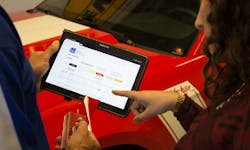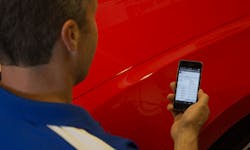One of the problems many MSO’s have (and most independent shops too, for that matter), is so much time spent on matching color.
According to Jim Pease, Director Shop Operations, Montrose Ford in Fairlawn, Ohio, “Speed equals money. Speed in our shop is everything. The faster you can get a car done and through the process, the more money you’re going to make.”
And Pease should know. His dealer collision repair centers have been a partner with Geico for eight years now and have ranked #1 three years in a row as the fastest production shop in the United States. In all, his four shops in Northeast Ohio bring in about $16 million a year – and continue to grow.
However, Pease notes they could grow much faster – both in terms of productivity and profitability – if there was a way for him and his team to cut time during the tedious process of color retrieval.
“Typically when we look up a color on the current system we have to filter through so many choices and variables,” says Pease, “I think if we could get a process together that would simplify that and get us to the color quicker, then no doubt it would definitely help.”
In fact, he points it out very clearly: “The average time to verify a color is up to 30 – 45 minutes, so if I can cut that in half I think to the bottom line I’m going to be able to produce at least one more car a day, maybe two. So, then if we average 18 cars a day throughput, then I get that to 19 to 20 cars a day - at an average of $2,000 per repair order - I’m probably going to produce about another 10% in revenue.”
“Twenty more cars a month for me obviously equal more profit,” Peace adds.
And in the case of an MSO – those additional cars per day are quickly multiplied by the number of locations in the network resulting in a significant increase in potential revenue each month.
If MSO’s can make more profit turning out more cars – and to do so they simply need to streamline their teams’ color management time – then why is there a bottleneck?
The problem is that so many of the existing color retrieval systems are slow, cluttered, and difficult to enhance, change, or maintain because they are built on aged platforms. Given the high level of turnover that most MSO’s face, a color retrieval system not only needs to be fast and simple, but also easy to learn and use for even the most inexperienced painter. Further, MSO’s need a simple, easy to use color retrieval system that an estimator or event greeter can use to quickly identify a color at the beginning of the repair process, long before the vehicle is moved into the paint booth.
Simple and easy to use means that the system eliminates as many decisions in the color retrieval process as possible and guides that technician to the color, eliminating the need for blending and tinting as much as possible. Getting to the right color not only increases the number of vehicles that can be delivered each day, but it also eliminates the potential for costly redo’s and improves that overall efficiency of the paint department.
However, there is a solution on the horizon: Sherwin-Williams Automotive Finishes recently introduced its premium web-based FormulaExpress® 2.0 Color Retrieval System.
The new FormulaExpress 2.0 Color Retrieval System is used to achieve the best color match results in the shortest possible time, resulting in improved profitability, cycle time, and customer satisfaction.
Faster systems like these are much more efficient for the automotive repair industry. With it, painters and technicians will spend much less time picking the right color for the job, and much more time delivering vehicles. This increases throughput, productivity and profit in all types of collision repair facilities.
FormulaExpress 2.0 formulas are intuitively sorted by popularity instead of the "standard with alternates" method widely used by many existing color retrieval systems. Additionally, this system has a unique patent-pending Color Filter™ feature. This feature helps guide the painter to the right color by selecting a few, very simple, user-friendly filters. No other system has such an intelligent way to pick from a set of variations.
The result is that better, faster color information is now just a click away. Unlike other systems that require the user to know the specific information about the vehicle in order to populate the correct search boxes (formula code, color code, color chip, etc.), the new system is intelligent enough to allow the user to enter whatever they know about the vehicle into one box that will pull precise color information with just a click. As a result, the system’s speed and look is greatly improved. Boasting a sleek and simple style, the system provides intuitive search functionality, and is extremely fast, reliable and provides real-time updating.
In addition, Formula Express 2.0 works in conjunction with the iFEX® spectro is a hand-held spectrophotometer designed for precise and consistent color measurement. This simple to use color tool makes for even faster selection of color formulas to further move more vehicles through the shop by eliminating the wasted time and expense of extended color matching.
FormulaExpress 2.0 also provides simple storing, tracking and reporting. Designed to work with multi-platforms including tablets, smartphones and PCs, it has the most updated color information readily available, 24/7, 365 days a year.
According to Marty Moon, lead painter from Ernie’s Auto Body in Hayward, Wis., the new system is much easier to navigate; provides easier click-throughs, and definitely increases his shop’s throughput. This means he’s getting more cars through the booth each week.
Moon noted he had been with Ernie’s (which is part of MSO Key Choice) since 2004, but has been painting since the late 1970s. “Now like a lot of folks from my generation, I’m not really a computer guy – but if I can understand it, anyone can!
“You have to remember, I’m originally from that era where back in the day to retrieve color we had to use triple-beam scales and microfiche; you bump the system, takes another 5 to 10 minutes to go back and reset the thing,” says Moon. “And then you only got color updates whenever the manufacturer felt like sending you new microfiche formulas.”
“We then went on obviously, to use more modern color management systems via the computer, but even these processes before Formula Express 2.0 were pretty involved,” Moon continues, “It took you awhile to get to where you needed to go; but now there’s a lot less clicks, and the icons are much easier to use.”
To help bring about this new system, Moon was one of the almost 30 painters from Key Choice Collision Centers, a leading upper Midwest consortium of collision repair centers, that sent all their painters into Sherwin-Williams Automotive headquarters to work on the development of the color retrieval system.
“We kind of feel the heartbeat of the FormulaExpress 2.0. is about all the painters that participated in a number of roundtables when we all went to Cleveland,” adds Moon, “We all had input on the project; what painters really needed, where we saw glitches or slowdowns in the present color search methods. With this give and take we ended up receiving a pretty effective program. We really appreciate the company asking our opinions, and then following up with training in all our shops to seamlessly transition to the new program.”
John Magowan, president of Ernie’s Auto Body and a founding partner with Key Choice notes how important such an advanced color management system is for an MSO like his. “Beginning our brand slowly, we have now been adding facilities to our organization that are primarily adapting lean-driven processes.”
“Obviously a faster and far more efficient color retrieval system fits right into those plans. By dramatically decreasing the time to verify color this new system really makes all our shops far more productive and we all benefit from that,” notes Magowan.
MSO Key Choice’s 15 shops have all doubled their sales and growth in the past few years. They rely on the efficiencies the entire group utilizes by being similarly driven, mid-sized shops serving rural and somewhat small markets (note: many of the partners started out in a 20 Group, and hence run their organization in a similar manner). Magowan reports that this type of color retrieval management system is imperative for not just each of its individual facilities, but as a whole, that is extremely consistent with their business model.
Better, faster color needs to become the new normal. MSOs as well as independent, dealer, independent and all other types of collision repair facilities will soon not only expect it – but demand it. New systems like FormulaExpress 2.0 can’t just be fast, they also need to be extremely versatile. For example, this new system is functional with every automotive finish intermix and factory pack system that Sherwin-Williams provides, with access to more than 750,000 color formulas. It also works in conjunction with the brand’s color tools, including the PROSPECTOR® color reference system and Color Works® The Match Box (for fleet refinish and OEM colors).
For more information about Sherwin-Williams Automotive Finishes FormulaExpress 2.0, visit www.sherwin-automotive.com/formula-express or call 1-800-798-5872.



